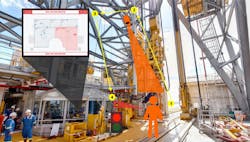Rolloos combines cameras and IIoT software from OSIsoft for oil rig safety
While monitoring individual people moving around in offices or on plant-floors is problematic to begin with, what can you do if everyone is on an oil rig in the middle of the ocean?
Well, Rolloos reports it recently helped an offshore drilling operator keep better track of each on-rig staffer at all times by moving beyond its visual confirmation and existing closed-circuit TV (CCTV) equipment to develop a comprehensive red-zone detection system. This solution integrated the platform's CCTV devices with 16 new camera-based smart sensors from Rolloos and Edge Data Store (EDS) IIoT software from OSIsoft, which made sure all drill floor data was accessible to offshore operators for immediate decision support and could be streamed onshore for retrospective analysis. Not only did this optimize drilling processes and improve performance, but it also enabled real-time monitoring of people and heavy machinery. Rolloos also uses deep-learning algorithms and timer-series data integrated with documents and manuals to optimize maintenance management.
“EDS came onboard because we needed a historian onsite. We went through its API management, and an hour later I had it spun up on a docker container, and it was talking to a mobile simulator. It was really easy to do,” explains Martijn Handels, director at Rolloos. “Now, we have people data and location data, and that lets us analyze how we work. We can track individuals from video, combine that information with outputs from the equipment, improve efficiency even more, and use EDS to stream it back to shore."
To give its red-zone system the networking and reduced data latency it required, Rolloos assigned the EDS software to collect, store and stream data from its 16 cameras just on the rig. Combined with a full, private LTE wireless network, EDS allows users to paint a complete picture of all people and assets moving on the drill floor. The software's algorithms were able to detect human faces, but didn't have the triangulation needed to determine their precise locations. As a result, Rolloos repositioned the cameras 10 meters above the drill floor and retrained the algorithms to let the cameras capture the crew's movements, which allowed the EDS system to provide that data to the rig's driver personnel.
However, with 10-20 screens running at once, the drivers also needed a simple interface to efficiently see what the cameras were seeing. Once it was added, with one touch, they could view simplified images in which human movement is represented by red dots. The cameras automatically detect when someone breaches the red zone, and trigger audio and lighted alerts, so the drivers can make potentially life-saving decisions. The red-zone system is also scalable and open, allowing data to be shared with other systems and users. Plus, when a new process application is added, users can train the algorithms onshore, and push the new configurations offshore, so they can run on the rigs. These offshore visualizations run on EDS, and are fed to the PI Server, where they can connect to third-party apps or the client’s PI Server via PI Cloud Connect.
“We’ve opened up the data that’s coming from our systems to everybody. It isn't a closed system, so we’re sharing inputs and outputs,” says Handels. "EDS enabled Rolloos to deploy centralized dashboard management for all the rigs, ensuring the safety of their critical, remote personnel and improving overall process performance."
Enrique Herrera, industry principal for the Manufacturing and Connected Services division at OSIsoft, reports, "We've been assisting customers to get value from their operational data, but we're seeing that COVID-19 is disruptive. End users are shutting down or running skeleton crews and are having to make dynamic leaps. Fortunately, many operators and maintenance people are mobile already, and are sharing passive and tacit knowledge from remote troubleshooting and other activities. As a result, wearable interfaces and PCs started out in low volumes, but now they're reinventing the mobile phone format. Users are collaborating by sharing images and videos, and bringing operations into this collaborative environment. It's kind of a chicken-and-the-egg question: did collaboration in plants bring in operations data, or did operations deliver collaboration to their facilities?"
Herrera adds the Industrial Internet of Things (IIoT) and its server-based infrastructure and edge devices have always driven and enabled local and remote connectivity. However, even though mobility technologies aren't new or innovative, they're being experimented with more, especially now that they've become essential must-haves. For instance, some server- and edge-based systems are being broken into multi-tiered software architectures, such as OSIsoft's PI Edge, which can do computing wherever it's available by storing data in edge locations and establishing messaging to reach their servers.
"The technology is there to do things like checking elevated body temperatures, while still maintaining privacy and quarantining without stigma," adds Herrera. "The challenges in the rollout and how and where to do it now."
About the Author

Leaders relevant to this article:


